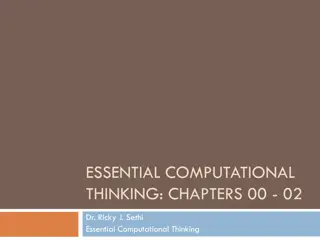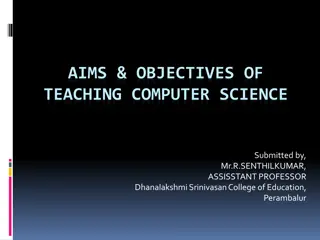Information Technology Overview and Objectives in Computer Science Department at AAUA, Nigeria
This course covers the historical perspective, storage and retrieval of information, advantages of information technology, and the evolution of computers. Students will learn about the intricacies of information systems, components of IT infrastructure, and the various generations of computers. The module includes lectures, discussions, tests, assignments, and exams to assess comprehension and application of the concepts presented.
Download Presentation

Please find below an Image/Link to download the presentation.
The content on the website is provided AS IS for your information and personal use only. It may not be sold, licensed, or shared on other websites without obtaining consent from the author. Download presentation by click this link. If you encounter any issues during the download, it is possible that the publisher has removed the file from their server.
E N D
Presentation Transcript
P.O. Ogunmolu: Computer Science Department, AAUA, Nigeria CSC 101: Introduction To Computer Systems (2 Units) OUTLINE Information Technology (IT): An Historical perspective Storage and retrieval of information Advantages of IT Evolution of computers 10/8/2024
Overview 2 MODULE STRUCTURE Module will entirely be based on instructions and class discussions/activities There will be test(s) and assignment(s) Module is split between four lecturers who will cover various aspects of the course Examination Based on material presented in the notes, lectures developed through assignment essays. Exams will be 2 3 hours in length and evenly split over all covered topics. The paper will cover 70% of the 2 Units Continuous Assessments - Class works, Assignments, Attendance and Tests. Will constitute 30% of the 2 Units P.O. Ogunmolu: Computer Science Department, AAUA, Nigeria 10/8/2024
Objectives 3 At the end of the modular instructions, the student should be able to: Understand the intricacies of the information systems Why have an information system? Advantages of information technology Components of an information technology infrastructure Evolution of computers Thoroughly understand the various generations of computers viz., first generation, second generation, third generation, fourth and fifth generation computers P.O. Ogunmolu: Computer Science Department, AAUA, Nigeria 10/8/2024
Lecture and learning 4 Mixture of slides and learning Discussion You may have to go and learn topics on your own Take note of what I say, others say and what I write Ask questions, make comments, argue within the bounds of reason Read Reference Materials though lectures and slides would be enough Tutorial questions, assignments, essays are good practising tools for exam P.O. Ogunmolu: Computer Science Department, AAUA, Nigeria 10/8/2024
Information Technology: Introduction 5 Informationtechnology has been around since the beginning of time Think of the story of creation or the theory of evolution animals displaying courtship behavior man s means of long-distant communication during the stone age the Egyptians during the era of the Pharaohs letters through the middle ages codes and lately electronic modes of communication such as fax, telephone, the internet and etc. P.O. Ogunmolu: Computer Science Department, AAUA, Nigeria 10/8/2024
Historical Evolution of IT: PRE-HISTORIC AGE 6 PRE-HISTORIC AGE (3000 B.C. 1450 A.D) Human used language and speech or petroglyphs to propagate bidirectional communication Then came Phoenician alphabet The counting table was invented in China in 400B.C. and Abacus was used in China around 500 B.C. [3] PETROGLYPHS [1] Following the development of alphabets, we developed pens and the paper Early forms involved marks in wet clay and then we made paper out of papyrus plants The Chinese made paper out of rags somewhere in this era Written information necessitated the invention of books and libraries The Egyptians invented the scroll P.O. Ogunmolu: Computer Science Department, AAUA, Nigeria 10/8/2024
Historical Evolution of IT: PRE-HISTORIC AGE 7 The first numbering systems (numbers 1 9) were invented in India during this age (~1000A.D..) The number 0 was subsequently invented in 775 years afterward in 875AD The Roman Abacus was used about 2400 B.C in Babylonia [2] After most of these developments were made, people started developing machines or calculators that could: Execute automated calculations Control processes and data (or information), and Control continuous processes or discrete devices P.O. Ogunmolu: Computer Science Department, AAUA, Nigeria 10/8/2024
Historical Evolution of IT: PRE-HISTORIC AGE 8 The Mechanical Abacus P.O. Ogunmolu: Computer Science Department, AAUA, Nigeria 10/8/2024
Historical Evolution of IT: Mechanical Age 9 The conditions created by the flurry of inventions during the pre-historic age brought about the mechanical age The Mechanical Age (approx. 1450 1840 A.D.) Was the precursor to our electronic information age In 1623: Wilhelm Schickard, a German polymath, designed a calculating clock: it was destroyed in a fire accident during its construction in 1624 and Schickard left the project. Two sketches of it were discovered in 1957; too late to have any impact on the development of mechanical calculators 1624: Blaise Pascal invented the mechanical calculator (called the Pascaline) after some creative work and subsequently built 20 more prototypes in the following ten years. Approx. 1672: Gottfried Wilhelm von Leibniz pioneered the Stepped Reckoner and his famous cylinders while adding direct multiplication and division to the Pascaline. Leibnitz s invention waas far ahead of his time. A working model did not appear until 1791 long after Leibnitz was dead and gone. P.O. Ogunmolu: Computer Science Department, AAUA, Nigeria 10/8/2024
Historical Evolution of IT: Mechanical Age 10 Schickard s Slide Rule P.O. Ogunmolu: Computer Science Department, AAUA, Nigeria 10/8/2024
Historical Evolution of IT: Mechanical Age 11 Blaise Pascal s Pascaline P.O. Ogunmolu: Computer Science Department, AAUA, Nigeria 10/8/2024
Historical Evolution of IT: Mechanical Age 12 1903: In Japan, Ry ichi Yazu patented a mechanical calculator called the Yazu Arithmometer consisting of a single cylinder and 22 gears, and employing the mixed base-2 and base-5 number system well-versed by users of the soroban (Japanese abacus). Carry and end of calculation were automated. He sold over 200 units mostly to Japaanese government agencies such as the Ministry of War and agricultural experiment stations In 1801, Joseph-Marie Jacquard developed a loom in which the pattern being woven was controlled by punched cards. The series of cards could be changed without changing the mechanical design of the loom. This was a landmark achievement in programmability. His machine was an improvement over similar weaving looms. Punch cards were preceded by punch bands, as in the machine proposed by Basile Bouchon. P.O. Ogunmolu: Computer Science Department, AAUA, Nigeria 10/8/2024
Historical Evolution of IT: Electro-Mechanical Age 13 Jacquard s revolutionized textile-weaving methods opened the way for the electromechanical systems that followed Jacquard s invention also provided model for the input and output of data in electro- mechamical (abbreviated as e:m henceforward) systems EnterCharles Babbage (11791 1871): Generally considered the father of modern computers His difference engine (1833) and analytical engine (1837) which significantly improved on Jacquard s punched-tapes - foreshadowed the creation of modern computers Led a terrific life: invented the cowcatcher, dynamometer, standard railroad gauge, uniform postal rates, occulting lights for lighthouses, Greenwich time signals, heliograph opthalmoscope P.O. Ogunmolu: Computer Science Department, AAUA, Nigeria 10/8/2024
Historical Evolution of IT: Electro-Mechanical Age 14 Babbage s difference engine was possible because of the advances that occurred after the industrial revolution The difference machine never reached full fruition in its development Babbage drew up the blueprint for the difference machine as a Cambridge Univ. Undergrad He abandoned the design for a much-better Analytic-engine Charles Babbage s difference machine P.O. Ogunmolu: Computer Science Department, AAUA, Nigeria 10/8/2024
Historical Evolution of IT: Electro-Mechanical Age 15 Babbage s analytical engine was a general-purpose programmable computer, employing punch cards for input and a steam engine for power, using the positions of gears and shafts to represent numbers The Analytical Engine was intended to use loops of Jacquard's punched cards to control an automatic calculator, which could make decisions based on the results of previous computations. This machine was also intended to employ several features subsequently used in modern computers, including sequential control, branching, and looping Though the design was sound and the plans were fairly accurate/debuggable, the project suffered due to rows with the chief machinist building parts for it. All parts for his machine had to be manually made. Small errors in each item could result in large discrepancies. P.O. Ogunmolu: Computer Science Department, AAUA, Nigeria 10/8/2024
Historical Evolution of IT: Electro-Mechanical Age 16 Babbage s machine required lots of interconnected parts which demanded extreme accuracy, tolerance and sensitivity requirements that were not available at that time With quarrels with artisans and the pace of tech. advancement, the British Government had to discontinue funding for the project Charles Babbage s Analytical Machine P.O. Ogunmolu: Computer Science Department, AAUA, Nigeria 10/8/2024
References 17 [1] Brady http://openbookproject.net/courses/intro2ict/history/history.html, [Accessed on 5/4/2014] Shubham Shrivastava and Raghvendra Singh, Computer Project on History of Computers Davis, Ruth M., Evolution of Computers, SCIENCE VOL 195 W., and Elkner J., History of Information Technology, 2011. [2] [3] P.O. Ogunmolu: Computer Science Department, AAUA, Nigeria 10/8/2024

























